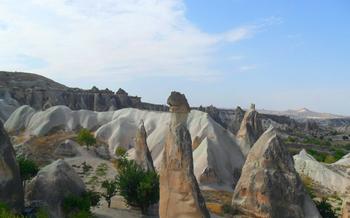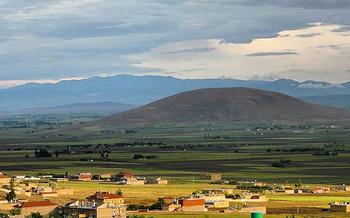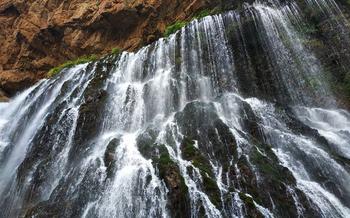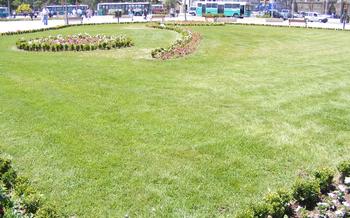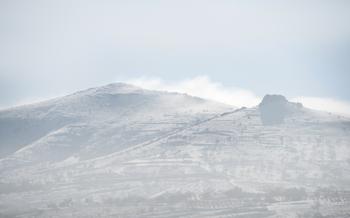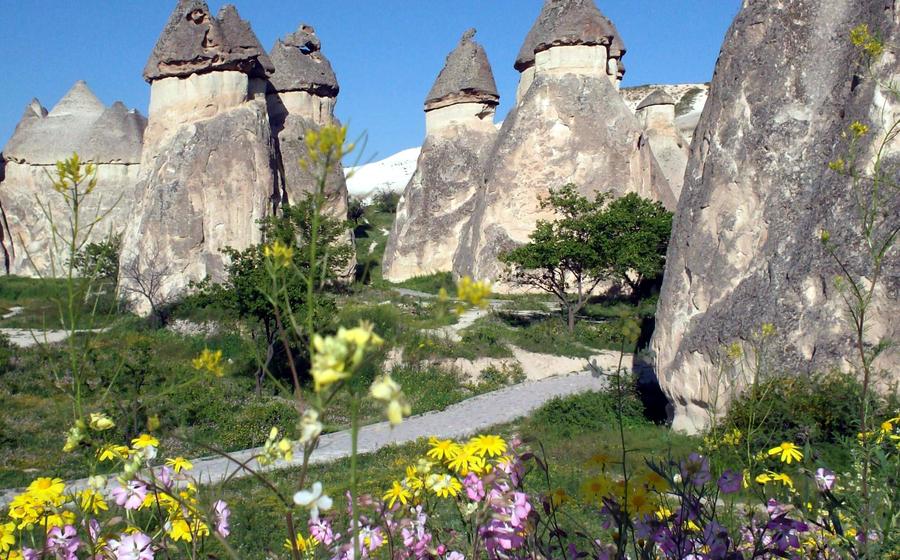
Gaziemir Underground City
- Gaziemir Underground City: A Historical Marvel beneath Nevşehir
- Location and Access
- Opening Hours and Admission Fees
- Guided Tours
- Exploring the Underground City
- History and Legends
- Architectural Marvels
- Ventilation and Water Systems
- Religious Structures
- Living Conditions
- Safety Precautions
- Photography and Videography
- Nearby Attractions
- Accommodation and Dining Options
- Insider Tip:
Gaziemir Underground City: A Historical Marvel beneath Nevşehir
Gaziemir Underground City is a remarkable historical site located in the heart of Nevşehir, Turkey. Its origins trace back to the 7th century BCE, when the Phrygians, an ancient Anatolian civilization, constructed the initial chambers and tunnels. Over the centuries, the city underwent expansions and modifications by subsequent civilizations, including the Romans, Byzantines, and Seljuks. It served as a refuge for local communities during times of war, persecution, and natural disasters, providing a safe haven from invading armies and harsh weather conditions.
Gaziemir Underground City is a testament to the ingenuity and resilience of the people who inhabited it throughout history. Its intricate network of tunnels, rooms, and ventilation systems allowed its inhabitants to live and thrive underground for extended periods. The city's historical significance and unique architectural features make it a must-visit destination for anyone interested in history, archaeology, and subterranean exploration.
Location and Access
The Gaziemir Underground City is situated in the heart of Nevşehir, a city in central Turkey renowned for its historical and cultural significance. Nevşehir is well-connected to major cities in Turkey, making it easily accessible by various modes of transportation.
To reach Nevşehir from Istanbul, the country's largest city, one can take a direct flight or travel by bus or train. The journey by air takes approximately 1 hour and 15 minutes, while the bus or train journey takes around 10 hours.
Once in Nevşehir, visitors can easily reach the underground city by taking a taxi or a local bus from the city center. The journey from the city center to the underground city takes approximately 15-20 minutes.
Opening Hours and Admission Fees
Gaziemir Underground City is open to visitors daily from 9:00 AM to 7:00 PM during the peak season, which typically falls between May and October. During the off-peak season, which is from November to April, the opening hours may vary or be shorter. It's advisable to check the official website or contact the local tourism office for the most up-to-date information on opening hours.
The admission fee for the underground city is currently 60 Turkish Lira for adults and 30 Turkish Lira for students. Children under the age of 6 are admitted free of charge. There are no additional discounts or fees for guided tours.
When planning your visit, it's worth considering the peak and off-peak seasons. During the peak season, the underground city tends to be more crowded, especially during weekends and holidays. If you prefer a quieter and more intimate experience, it's recommended to visit during the off-peak season or on weekdays. Keep in mind that the weather conditions during the off-peak season can be colder and wetter, so it's essential to dress accordingly.
Guided Tours
There is a wide variety of guided tours available, allowing you to discover the intricate history and hidden chambers of the Gaziemir Underground City. These tours are typically led by experienced guides who provide insightful commentary and historical background, bringing the ancient city to life. Visitors can choose from group tours, catering to different interests and languages, or opt for a private tour for a more personalized experience. The cost of guided tours varies depending on the group size, tour duration, and any additional services or inclusions.
Exploring the Underground City
Gaziemir Underground City's subterranean labyrinth is a treasure trove of hidden chambers, tunnels, and fascinating discoveries. As you venture through its depths, you'll be amazed by the intricate layout that allowed an entire civilization to thrive beneath the surface.
The city's multiple levels are connected by narrow passageways and staircases, creating a maze-like structure. Explore the living quarters, complete with kitchens, bedrooms, and storage areas, where people sought shelter from invaders and harsh weather conditions. Discover the communal spaces, such as meeting rooms, stables, and workshops, where the community came together for various activities.
Key features to look out for include the ventilation system, which ensured a constant supply of fresh air, and the water storage and distribution system, which provided a vital resource for the city's inhabitants. Marvel at the skillful construction techniques and the ingenious use of materials, such as volcanic tuff and limestone, which have preserved the city's integrity over centuries.
A typical visit to the underground city can last anywhere from one to two hours, allowing you ample time to explore its various sections and learn about its rich history. Get lost in the maze-like tunnels, uncover the secrets of the past, and immerse yourself in the fascinating world that lies beneath the surface of Nevşehir.
History and Legends
The Gaziemir Underground City has a rich and fascinating history, dating back to the Byzantine era when it was constructed as a refuge from invading armies. Over the centuries, it has served various purposes, from a hideout for early Christians to a shelter during wartime.
Local legends and folklore are closely intertwined with the history of the underground city. One tale tells of a beautiful princess who was hidden in the city to protect her from an evil king. Another legend speaks of a secret tunnel that leads to a hidden treasure chamber, waiting to be discovered by a worthy adventurer.
These stories add an air of mystery and intrigue to the underground city, captivating visitors with their timeless charm. As you explore the ancient tunnels and chambers, you can't help but feel a connection to the past and the people who once sought shelter within these hidden depths.
Architectural Marvels
The Gaziemir Underground City showcases remarkable architectural achievements that reflect the ingenuity and skill of its ancient builders. Constructed entirely underground, the city features multiple levels connected by narrow tunnels and staircases. Each level served a specific purpose, with rooms designated for living quarters, storage, stables, and religious rituals.
The construction techniques employed in the underground city are particularly noteworthy. The builders utilized local volcanic rock to create sturdy walls and ceilings, ensuring the city's resilience against potential collapses. The use of arches and vaults provided additional structural stability, allowing the city to withstand the weight of the earth above.
The city's design and layout also demonstrated a keen understanding of urban planning. The narrow tunnels and staircases were strategically placed to facilitate efficient movement and provide defensive advantages. The ventilation system, consisting of cleverly designed channels and shafts, ensured a constant supply of fresh air throughout the city.
Overall, the Gaziemir Underground City stands as a testament to the architectural prowess of its ancient inhabitants. Its unique design, construction techniques, and ingenious use of space make it a fascinating example of subterranean architecture and a must-visit destination for anyone interested in ancient history and engineering marvels.
Ventilation and Water Systems
At the heart of Gaziemir's architectural ingenuity lies a remarkable ventilation system that ensured a steady supply of fresh air and prevented the buildup of humidity and toxic gases. A series of meticulously crafted air shafts and chimneys, strategically positioned throughout the city, facilitated a constant airflow, creating a breathable and habitable environment deep beneath the earth's surface. The convergence of these shafts at higher elevations generated a natural draft, effectively drawing out stale air and replacing it with fresh air from outside.
Equally impressive was the city's water management system, a testament to the advanced engineering prowess of its builders. Cisterns and reservoirs, carved into the rock formations, collected and stored rainwater, providing a vital source of potable water for the city's inhabitants. A network of channels and conduits, carefully engineered to distribute water throughout the underground city, ensured that every household had access to this precious resource. The efficient management of water not only sustained the community but also contributed to the overall hygiene and sanitation of the underground environment.
Religious Structures
The Gaziemir Underground City is not only a marvel of engineering but also a testament to the religious beliefs of its inhabitants. Within the city's depths, various religious structures have been discovered, each holding unique significance for the community.
Churches: Among the most prominent religious structures are two churches, one large and one small. The larger church features a central nave and two side aisles, with intricate carvings and frescoes adorning its walls. It is believed to have been used for communal worship and religious ceremonies.
Chapels: Several smaller chapels can be found scattered throughout the city. These intimate spaces provided a place for individual prayer and contemplation. They often contain niches or altars where religious icons or relics may have been placed.
Baptistery: The presence of a baptistery within the underground city suggests that the Christian community practiced baptism as a sacrament. The baptistery features a large stone basin, possibly used for full-immersion baptism.
The religious structures in the Gaziemir Underground City offer a glimpse into the spiritual lives of its past inhabitants. They serve as a reminder of the importance of faith and community, even in the face of adversity.
Living Conditions
The inhabitants of the Gaziemir Underground City lived a life of resilience and adaptation. Their daily routine revolved around various activities necessary for survival and community well-being. One primary task was farming. The city's underground chambers provided a controlled environment for growing crops, ensuring a steady food supply. The inhabitants cultivated a variety of vegetables, fruits, and grains, utilizing innovative farming techniques to maximize yield in the limited space.
Livestock played a crucial role in sustaining the city's population. Animals such as sheep, goats, and chickens were kept in designated areas within the underground city, providing a source of meat, milk, and eggs. Animal waste was repurposed as fertilizer, further enriching the soil for farming.
The underground city exhibited a remarkable level of organization and self-sufficiency. Craft workshops were established to produce essential goods such as pottery, textiles, and metal tools. The inhabitants displayed great skill and ingenuity in crafting these items, utilizing the resources available to them.
Daily life in the underground city was undoubtedly challenging. The inhabitants had to contend with limited space, darkness, and the constant threat of invasion or discovery. However, they demonstrated remarkable adaptability and resilience, creating a thriving community that endured for centuries.
Safety Precautions
The Gaziemir Underground City is a safe and well-maintained site for visitors. However, there are a few safety precautions to keep in mind to ensure a smooth and enjoyable experience:
-
Uneven Surfaces: The underground city's floors and stairs can be uneven or slippery, so wear sturdy and comfortable shoes with good traction.
-
Low Ceilings: Some areas of the city have low ceilings, so be mindful of your head to avoid bumps or injuries.
-
Confined Spaces: The underground city's tunnels and rooms can be narrow and confined, which may cause discomfort for those with claustrophobia.
-
Darkness: The city's interior is dimly lit, so bring a flashlight or use the flashlight function on your phone to navigate safely.
-
Stay on the Marked Paths: Stick to the designated paths and avoid exploring unmarked areas to prevent getting lost or encountering potential hazards.
-
Follow Instructions: Listen to and follow the instructions provided by the guides or signs regarding safety precautions and prohibited areas.
-
Children and Elderly: Ensure that children are supervised at all times, and assist the elderly or those with mobility issues as needed.
Photography and Videography
At the Gaziemir Underground City, capturing the essence of this subterranean marvel through photography and videography is permitted. To ensure a respectful and responsible experience, there are a few guidelines to follow. Flash photography is discouraged to avoid disturbing other visitors and preserving the delicate environment. Tripods and selfie sticks are also not allowed, as they can obstruct the narrow passageways. It's crucial to be mindful of your surroundings and avoid blocking the paths of other visitors while taking photos or videos.
The underground city offers a treasure trove of photo opportunities. From the intricate carvings on the walls to the unique architectural features, every corner holds a story waiting to be captured. Wide-angle lenses are recommended to capture the expansive chambers, while a macro lens can reveal the intricate details of the city's design. For those interested in videography, a steady tripod or gimbal is essential for smooth and stable shots.
To capture the most striking images, plan your visit during the golden hours of sunrise or sunset. The soft, diffused light casts a magical glow on the underground city, enhancing its visual appeal. Remember to respect the privacy of other visitors and avoid taking photos or videos that may be intrusive or disrespectful.
By following these guidelines, you can capture stunning memories of your journey through the Gaziemir Underground City while preserving the integrity of this remarkable historical site.
Nearby Attractions
The Gaziemir Underground City is not the only remarkable destination in Nevşehir. The region is home to a wealth of historical sites, museums, and natural wonders that are waiting to be explored. Here are a few recommendations for creating an itinerary that includes the underground city:
-
Göreme National Park and the Cappadocia Region: Located just a short drive from Nevşehir, Göreme National Park is a UNESCO World Heritage Site renowned for its stunning rock formations, cave dwellings, and vibrant history. Visitors can explore the park's many hiking trails, admire the intricate frescoes in the rock-cut churches, and even take a hot air balloon ride for a breathtaking aerial view of the landscape.
-
Uçhisar Castle: Perched atop a hill overlooking the Göreme Valley, Uçhisar Castle is one of the most prominent landmarks in Cappadocia. The castle dates back to the Byzantine era and served as a strategic military stronghold throughout history. Visitors can climb to the top of the castle to enjoy panoramic views of the region.
-
Ihlara Valley: A hidden gem located about 100 kilometers from Nevşehir, Ihlara Valley is a lush canyon that is home to numerous rock-cut churches, monasteries, and cave dwellings. Visitors can hike or bike along the Melendiz River, which flows through the valley, and explore the many historical sites nestled among the towering cliffs.
-
Nevşehir Museum: This museum houses a collection of artifacts that showcase the rich history and culture of Nevşehir and the surrounding region. Visitors can learn about the area's geological formation, see exhibits on the Hittite civilization, and admire a collection of pottery, jewelry, and other artifacts from various periods of history.
Accommodation and Dining Options
When planning your trip to Gaziemir Underground City, you'll want to consider your accommodation and dining options. Nevşehir offers a range of hotels and guesthouses to suit different budgets and preferences. For a comfortable and convenient stay, choose from hotels like the Grand Cappadocia Hotel or the Kelebek Special Cave Hotel, which offer modern amenities and easy access to the underground city. For a more immersive experience, opt for a traditional cave hotel like the Cappadocia Cave Suites or the Artemis Cave Suites, where you can sleep in a room carved into the rock formations.
For dining, Nevşehir offers a variety of local restaurants and cafes serving delicious Turkish cuisine. Be sure to try traditional dishes like testi kebab (clay pot kebab), manti (Turkish ravioli), and gözleme (stuffed flatbread). For a memorable dining experience, try one of the many rooftop restaurants that offer panoramic views of the city and the surrounding landscape. Some popular choices include the Nar Lokantası, the Seten Anatolian Cuisine Restaurant, and the Kapadokya Terrace Restaurant.
To find authentic Turkish cuisine, venture off the beaten path and explore the local markets and bazaars. Here, you can find fresh produce, spices, and traditional Turkish sweets. You can also try some of the street food stalls selling gözleme, kebabs, and other local delicacies.
Insider Tip:
For an unforgettable experience, plan your visit to the Gaziemir Underground City during the annual Nevşehir Underground City Festival. Held typically in September, this vibrant festival brings the city's history to life with traditional music, dance performances, and reenactments. Immerse yourself in the rich culture and heritage of the region as you witness local artisans showcasing their skills in pottery, weaving, and other crafts. Don't miss the opportunity to savor delicious Turkish cuisine and mingle with friendly locals, making your visit a truly immersive and memorable one.



